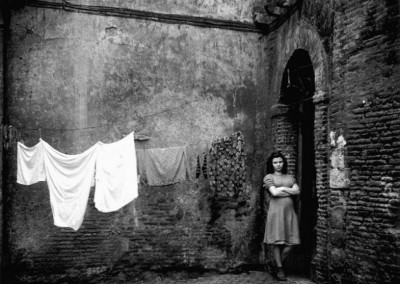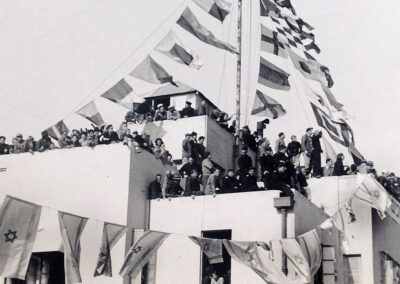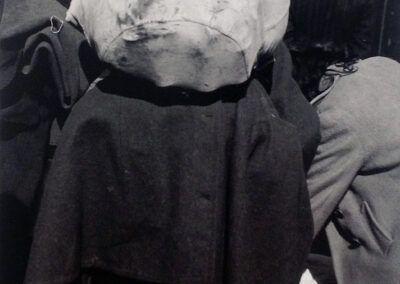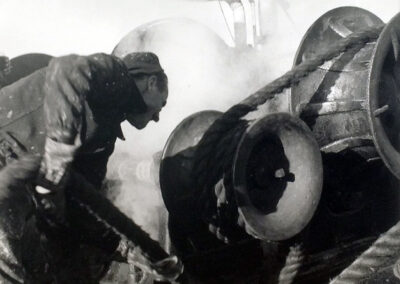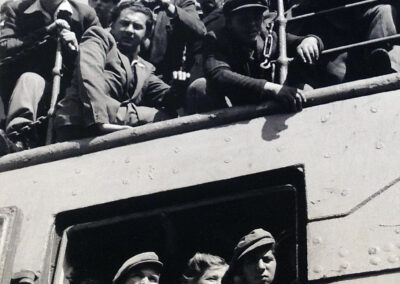
PAULA KOTIS
A native of New York City, PAULA KOTIS studied psychology at Hunter College, graduating in 1943. She learned photographic skills from her father in his Upper East Side portrait studio. Immersing herself in this work and eventually taking charge of the studio, Kotis began to produce and receive notice for her own pictures. Ms. Kotis studied the work of Henri Cartier-Bresson and others and commenced to produce a powerful body of photographs taken in New York and throughout Europe.
She was a gifted photographer whose magazine assignments brought her to post-war Europe and Israel in 1948-49, where she documented the dramatic changes taking place during that period. Her acclaimed photos from that time include images documenting the journey of Jewish Holocaust survivors from displaced persons camps near Famagusta, Cyprus to the port of Haifa in northern Israel. In the 1950s, Ms. Kotis collaborated on projects with the novelist James Baldwin and the poet Frank O’Hara, and photographed jazz greats including Sarah Vaughan and Charlie Parker. Her work has appeared in Vogue, Mademoiselle, Ebony, Arts, Evergreen Review and U.S. Camera.
Ms. Kotis had numerous exhibitions of her photography at the Schoolhouse Gallery in Provincetown, a major retrospective at the Provincetown Art Association and Museum in 2010, and exhibitions at the Museum of Jewish Heritage (2001), and the Ariel Meyerowitz Gallery in New York City (2000). Her work can be found in numerous private and public collections including the Museum of Modern Art, the Corcoran Gallery of Art, and The Provincetown Art Association and Museum. During her years in Wellfleet, Ms. Kotis was a mother, a real-estate agent, sold antique posters and, much to her joy, saw her photographic work rediscovered and appreciated.
CYPRUS TO HAIFA PORTFOLIO
In February 1949, Paula Horn Kotis sailed on an Israeli boat to Cyprus along with members of the international press to witness some of the last remaining Jewish refugees interned there. Her series of photographs entitled “From Cyprus to Haifa” documents scenes in the Cypriot detention camps, the ship’s return to Haifa with freed immigrants, and their arrival in the newborn State of Israel.
These 30 silver-gelatin prints were exhibited from November 14 – February 25, 2001 at the Museum of Jewish Heritage – A Living Memorial to the Holocaust in Battery Park City. Artworks, documents, and artifacts related to the history of Cyprus were included in the exhibition. Kotis’ photographs document a desperate hour for world Jewry. Fleeing post-war Europe, survivors of the Holocaust found themselves barred from entering Palestine due to British quotas. Forced to immigrate illegally, they boarded ships and ventured into the Mediterranean unsure of their fate. The British Navy overtook 39 of these ships, carrying a total of 52,000 passengers, and sent the people to Cyprus. On the Mediterranean island, the British government created a series of detention camps in order to prevent Jewish refugees from another attempt at entering Palestine. These detainees, the vast majority Holocaust survivors, endured deplorable conditions in Cyprus, some for a period of years. Eventually, through the intervention of the Israeli government, the British slowly allowed detainees to leave the camps and head for Palestine. Kotis captures the drama of these individuals as they journey from detention camp to ship to freedom. In one photo there is a Haifa-bound family of three — a father, mother and baby — all looking skyward in the same direction as if they were sharing the same vision. In another there is a small child weighted down with bags and wearing multiple layers of clothing, appearing ready to conquer whatever new circumstance presented itself.











